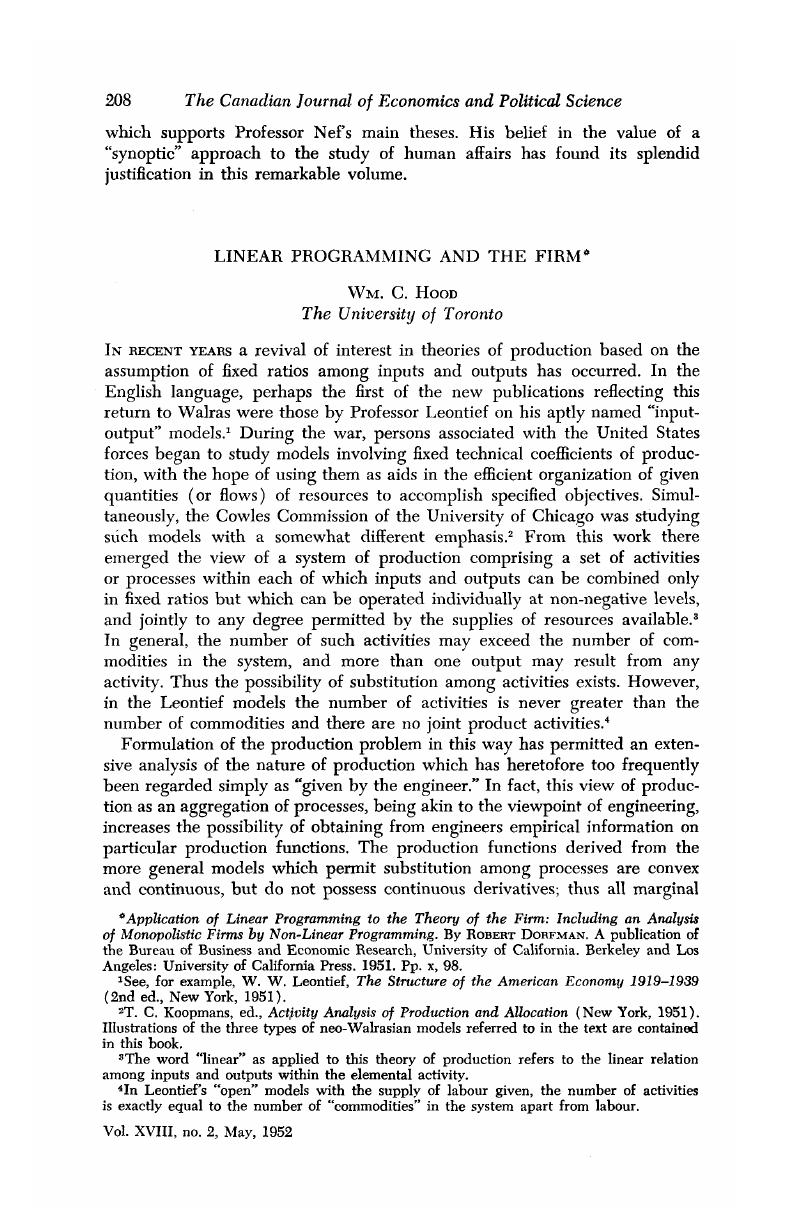Article contents
Linear Programming and the Firm*
Published online by Cambridge University Press: 07 November 2014
Abstract

- Type
- Review Articles
- Information
- Canadian Journal of Economics and Political Science/Revue canadienne de economiques et science politique , Volume 18 , Issue 2 , May 1952 , pp. 208 - 212
- Copyright
- Copyright © Canadian Political Science Association 1952
Footnotes
Application of Linear Programming to the Theory of the Firm: Including an Analysis of Monopolistic Firms by Non-Linear Programming. By Robert Dorfman. A publication of the Bureau of Business and Economic Research, University of California. Berkeley and Los Angeles: University of California Press. 1951. Pp. x, 98.
References
1 See, for example, Leontief, W. W., The Structure of the American Economy 1919–1939 (2nd ed., New York, 1951).Google Scholar
2 Koopmans, T. C., ed., Activity Analysis of Production and Allocation (New York, 1951).Google Scholar Illustrations of the three types of neo-Walrasian models referred to in the text are contained in this book.
3 The word “linear” as applied to this theory of production refers to the linear relation among inputs and outputs within the elemental activity.
4 In Leontief's “open” models with the supply of labour given, the number of activities is exactly equal to the number of “commodities” in the system apart from labour.
5 Especially T. C. Koopmans, “Analysis of Production as Efficient Combination of Activities,” chapter in of Activity Analysis of Production and Allocation; also his “Efficient Allocation of Resources,” Econometrica, xix, no. 4, 10, 1951, 455–65.Google Scholar
6 In addition to the works already cited, mention may be made of Morton, G., “Notes on Linear Programming,” Economica, n.s., XVIII, 11, 1951, 397–411.CrossRefGoogle Scholar
7 Such as, for example, Albert, A. A., College Algebra (New York, 1946)Google Scholar, or Albert, A. A., Solid Analytic Geometry (New York, 1949).Google Scholar
8 See G. B. Dantzig, “Maximization of a Linear Function of Variables Subject to Linear Inequalities”; chapter xxi of Koopmans, Activity Analysis of Production and Allocation.
9 See for example: G. B. Dantzig, “The Programming of Interdependent Activities: Mathematical Model,” Marshall K. Wood and Murray A. Geisler, “Development of Dynamic Models for Program Planning,” and Marshall K. Wood, “Representation in a Linear Model of Non-Linear Growth Curves in the Aircraft Industry”; chapters II, XII, and XIII respectively in Koopmans, Activity Analysis of Production.
10 Leontief, W., “Recent Developments in the Study of Interindustrial Relationships,” American Economic Review, Supplement, 05, 1949, 219.Google Scholar
11 Programming theory, as a view of production provides a means of describing a technological innovation, but not a theory of the growth and decline of production methods.
12 See Stigler, George, “Production and Distribution in the Short Run,” Journal of Political Economy, XLVII, 1939, 305–27.CrossRefGoogle Scholar
13 In one of its aspects statistical quality control is designed to assist engineers in utilizing knowledge of this random variability of processes to detect breakdowns of the process as deviations from the random pattern.
- 1
- Cited by


